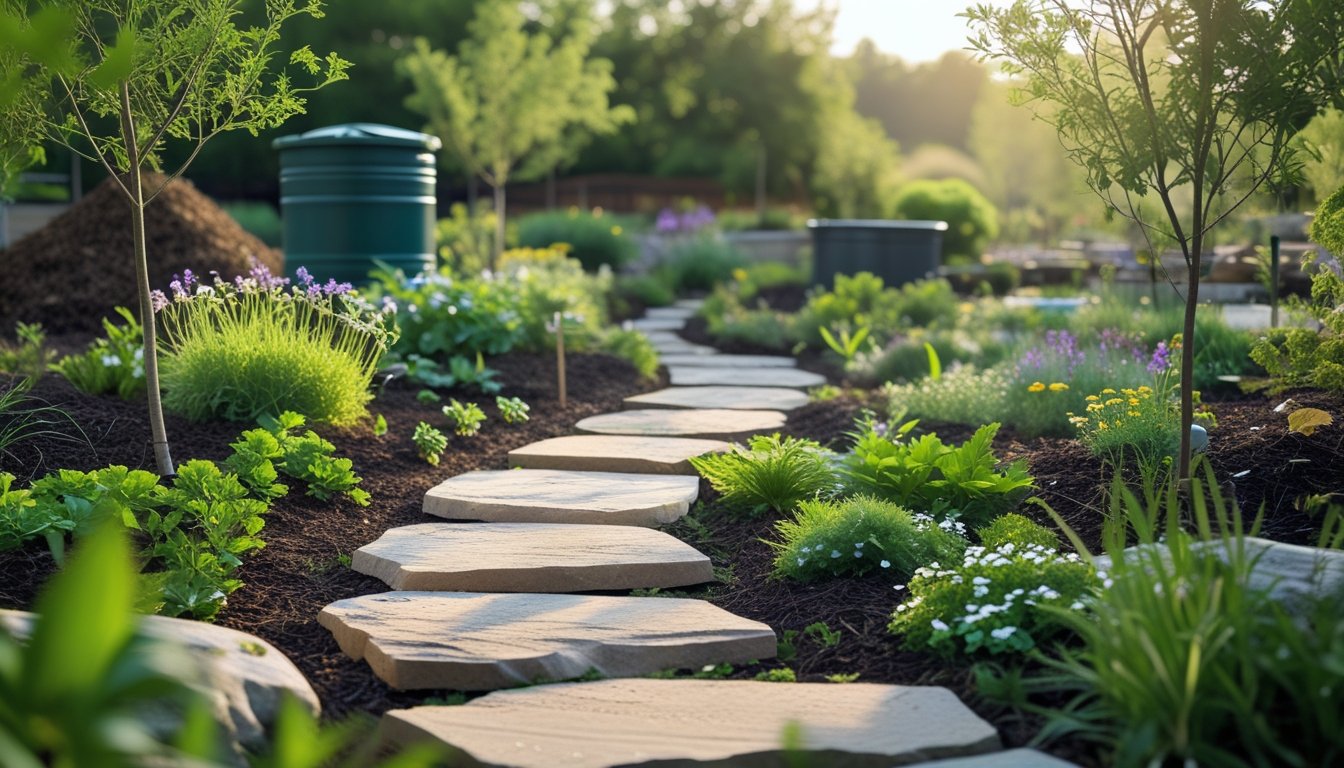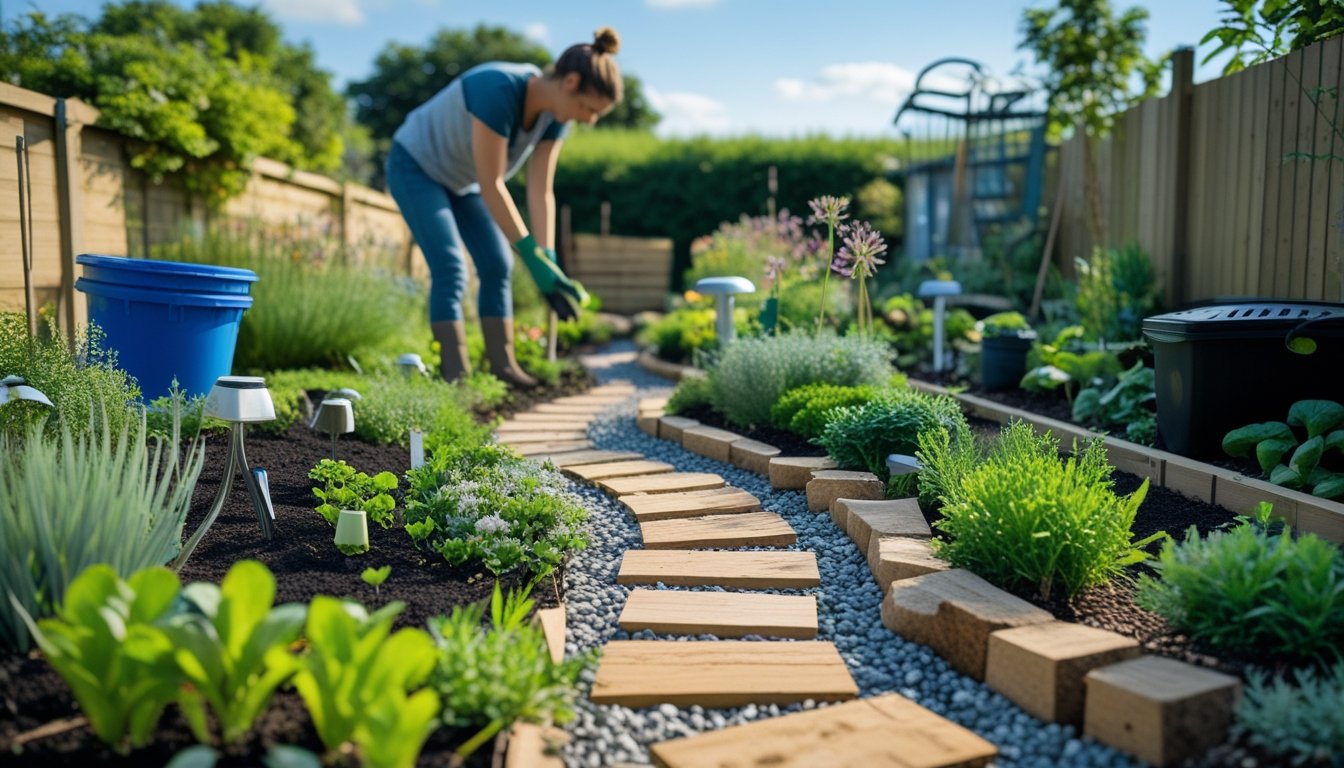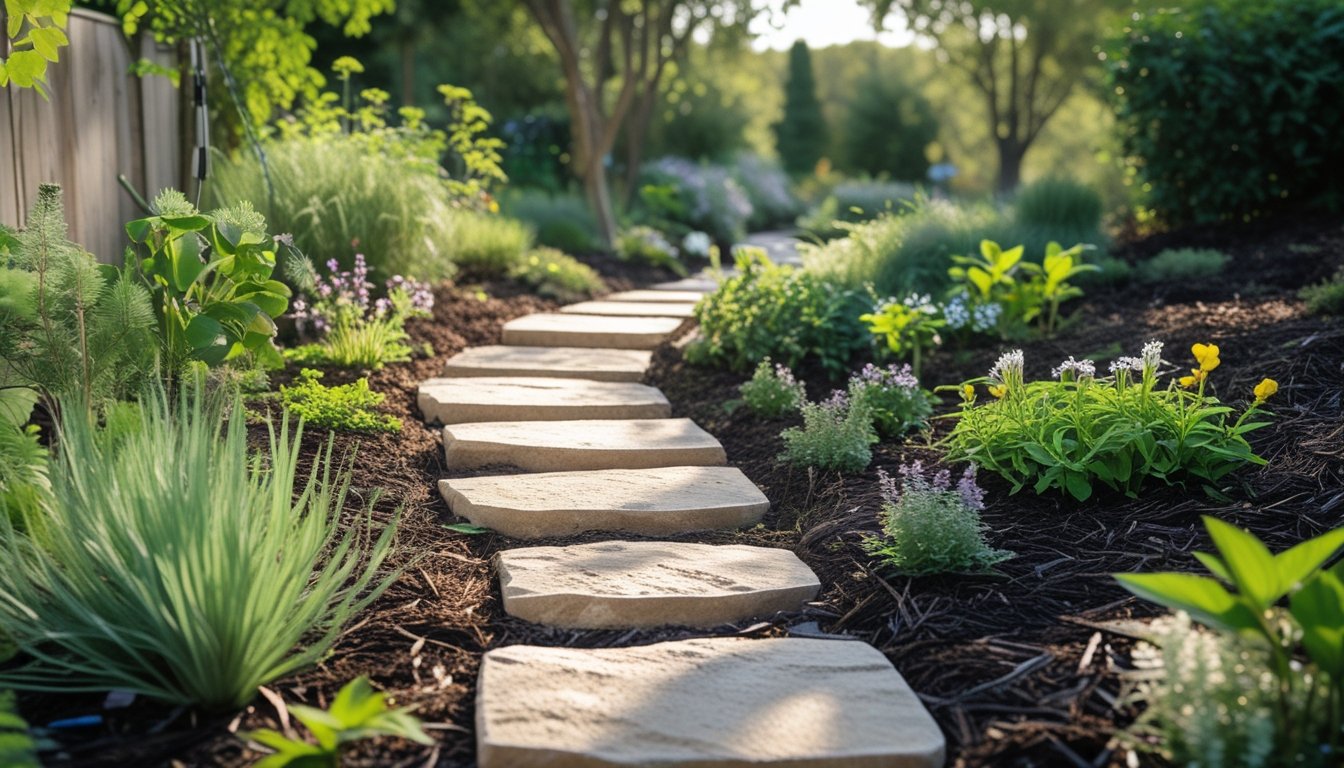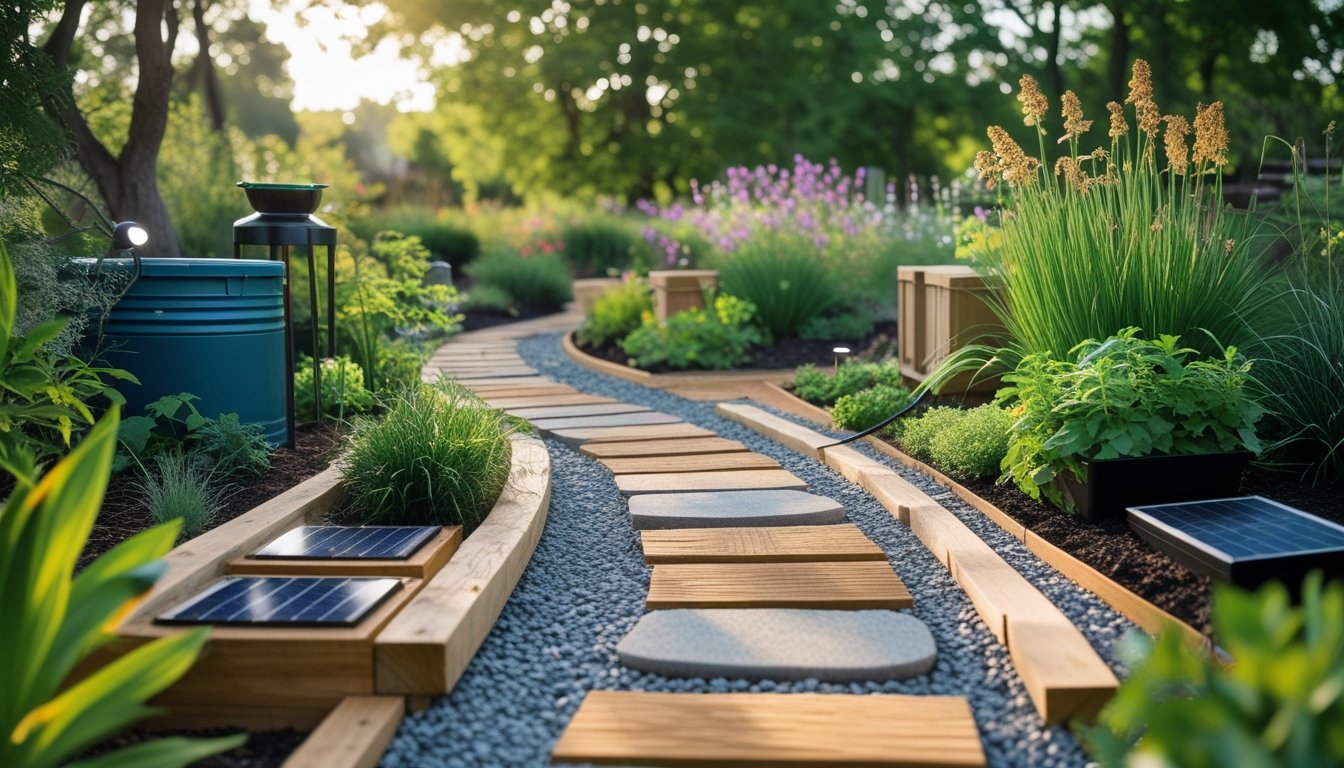Late updated: 08 Aug 2025 11:08
Written by: James Whitaker
Designing A Sustainable Small Garden Pathway: Expert Tips and Ideas
Creating a sustainable small garden pathway invites us into a world where practicality meets environmental consciousness. Sustainable garden pathways not only enhance the aesthetic value of our outdoor spaces but also promote eco-friendly practices. By choosing the right materials and designs, we can ensure that our paths harmonise beautifully with nature while serving functional purposes.

From innovative uses of reclaimed materials to the selection of native plants that blend seamlessly with surroundings, building a pathway becomes an act of stewardship. These paths guide us through our gardens, weaving an intricate narrative that balances both style and responsibility. The aim is to craft spaces that are not just visually appealing but also mindful of the environment.
Through thoughtful planning and the integration of sustainable choices, our garden pathways can transform our yards into eco-friendly havens. Whether our space is urban or rural, small steps towards sustainability make a significant impact.
Key Takeaways
- Sustainable paths blend beauty with eco-conscious materials.
- Thoughtful planning enhances functionality and aesthetics.
- Eco-friendly choices create positive environmental impacts.
Planning a Sustainable Small Garden Pathway

In planning a sustainable small garden pathway, we focus on understanding site conditions, optimising layout and flow, and balancing functionality with aesthetics. Thoughtful design choices ensure the pathway is both environmentally friendly and visually pleasing.
Assessing Site Conditions and Garden Needs
Before embarking on the pathway design, let's evaluate the specific conditions of the garden. We start by considering the soil type, drainage patterns, and sunlight exposure. Soil can affect the stability of the pathway, so determining whether it's sandy or clay-rich is important. Drainage needs careful planning to prevent waterlogging or erosion.
We must also think about how the garden is used. Do we aim to create a leisurely path for strolling, or is it primarily a functional route for garden maintenance? Knowing these needs guides material choices and design decisions. Importantly, consider the presence of existing features, like trees or flower beds, that could be incorporated or around which the path must meander.
Sustainable Pathway Layout and Flow
A key aspect of creating a sustainable garden path is designing a layout that harmonises with the natural topography and existing landscape elements. In sustainable design, straight paths are often replaced with gentle curves to follow the land's natural contours. This approach not only enhances the visual appeal but also aids in reducing erosion and runoff.
When it comes to the flow, the path should offer easy access to different parts of the garden without disrupting existing plantings. Materials like reclaimed brick or stone help in crafting eco-friendly pathways, adding both durability and a rustic charm. Using locally sourced materials further reduces the carbon footprint associated with transportation.
Functional and Aesthetic Considerations in Pathway Design
Balancing function and aesthetics is essential in pathway design. We must ensure it accommodates foot traffic comfortably—neither too wide nor too narrow. Considerations of safety and accessibility are vital; surfaces should be firm and slip-resistant, especially in wetter climates.
Aesthetically, the pathway should complement the garden's overall style. Whether we decorate it with native plants along the edges, or enhance it with decorative pebble stones, every choice should reflect our garden's personality. This blend of functionality and beauty ensures the pathway feels like an integrated, thoughtful part of the garden design rather than an afterthought.
Eco-Friendly Materials and Sustainable Planting Solutions

Creating a sustainable garden pathway requires careful selection of materials and plants that harmonise with the environment. We will explore the use of low-impact materials suitable for various climates, natural edging and drainage solutions, and the incorporation of greenery to enhance biodiversity along the path.
Choosing Low-Impact Materials by Climate
Selecting materials that suit the local climate is essential for a sustainable pathway. Stepping stones, pavers, and gravel pathways are excellent choices for dryer areas, as they allow water to permeate efficiently, reducing runoff. In contrast, concrete pathways may be more appropriate for regions with heavy rainfall due to their durability and resistance to erosion.
Decking can be an eco-friendly alternative if constructed from recycled or FSC-certified wood. By choosing locally sourced materials, we further minimise the carbon footprint associated with transportation. Additionally, recycled materials such as crushed glass or rubber can be innovative substitutes that combine sustainability with aesthetic appeal.
Natural Edging, Drainage, and Surface Options
A well-defined path benefits from natural edging solutions such as ornamental grasses and low-growing plants which retain soil and provide habitat for wildlife. Gravel paths and strategically placed stones can enhance drainage and prevent water accumulation, especially in areas prone to waterlogging.
Using mulch along the path edges not only improves aesthetics but also suppresses weeds and retains moisture. For surfaces, consider a boardwalk design where water-sensitive terrains exist. Boardwalks guide foot traffic while protecting fragile ecosystems below and promote accessibility through wetter landscapes.
Incorporating Greenery and Biodiversity Along the Path
The integration of greenery along garden pathways encourages biodiversity and enriches the garden environment. Climbing plants, such as Clematis or Ivy, can add vertical interest and habitat for insects and birds. Incorporating native species like Echinacea supports pollinators and maintains ecological balance.
Strategically placing garden edging that includes nectar-rich blooms invites pollinators along your pathway. Plants like lavender or thyme not only add fragrance but also attract bees. We can diversify plant choices by including both flowering varieties and evergreens, offering year-round interest and ecological benefit. Incorporating landscaping ideas that promote biodiversity ensures that our pathways contribute meaningfully to the local ecosystem.
Frequently Asked Questions

Designing a sustainable small garden pathway involves making informed choices about materials, ensuring good drainage, and incorporating native plants. Here, we explore the most common questions related to these aspects.
What are some eco-friendly materials suitable for constructing garden paths?
We often recommend using reclaimed materials such as bricks, stones, and wood for garden pathways. These options not only reduce waste but also add a unique aesthetic. Options like locally sourced gravel or bark can further minimise environmental impact due to reduced transportation emissions.
How can one ensure adequate drainage for a sustainable garden pathway?
Proper drainage is crucial. We suggest creating a slight slope on the path to guide water runoff naturally. Integrating permeable materials like gravel or permeable pavers can help absorb excess water and prevent erosion, maintaining both sustainability and aesthetics.
What design principles should be considered when creating a small garden pathway to reduce its environmental impact?
Minimising environmental impact starts with careful planning. We advocate for designing pathways that follow the natural contours of your garden, which reduces the need for extensive landscaping. Integrating renewable materials and designing for efficient water flow enhances both sustainability and functionality.
In what ways can native plants be incorporated into the design of garden pathways?
Incorporating native plants is a powerful way to enhance sustainability. We suggest planting native species along the edges or in adjacent beds. These plants can blend seamlessly with the pathway and support local biodiversity by attracting pollinators like bees and butterflies.
How can the longevity of a garden pathway be maximised using sustainable practices?
Durability can be achieved with thoughtful practices. Regular maintenance such as clearing debris and monitoring for pests is vital. We recommend choosing resilient materials and occasionally updating the path with more durable options as they become available, further extending the garden pathway's life.
What are some effective methods for maintaining a garden pathway without using harsh chemicals?
Maintaining pathways without harsh chemicals requires proactive care. We can use natural solutions like vinegar for weed control and regular sweeping to prevent debris accumulation. Additionally, incorporating ground covers can naturally suppress weeds while enhancing the path's visual appeal.
